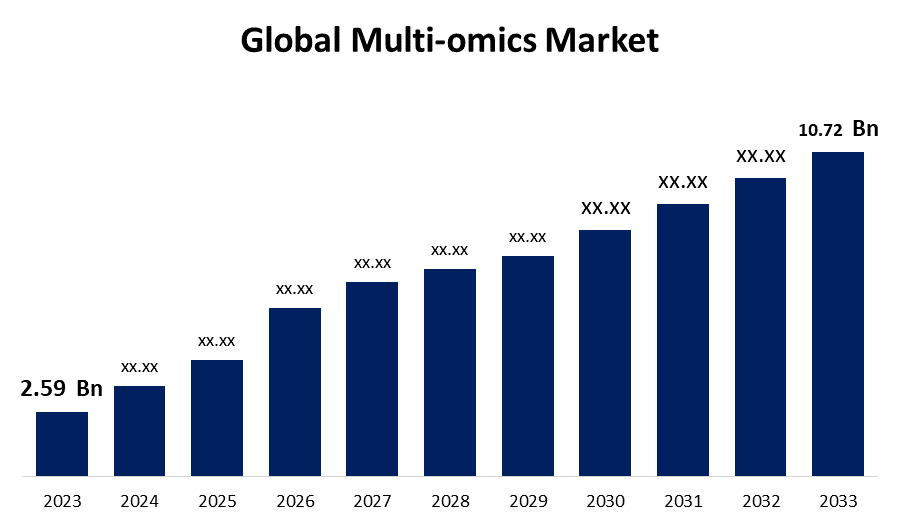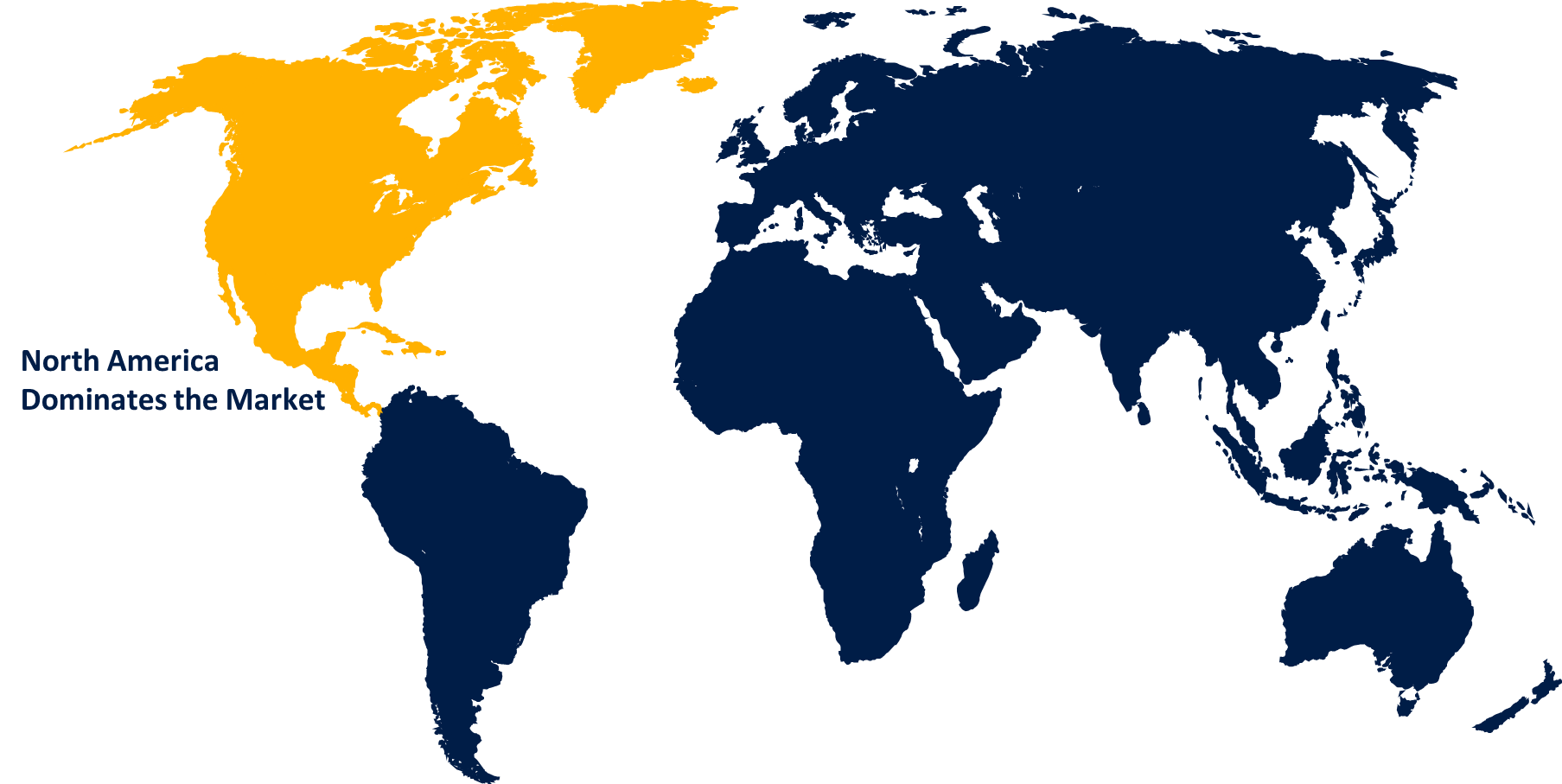Global Multi-omics Market Size, Share, and COVID-19 Impact Analysis, By Type (Single-cell Omics and Bulk Omics), By Platform (Genomics, Transcriptomics, Proteomics, Metabolomics, and Integrated Omics Platform), By Application (Cell Biology, Oncology, Neurology, Immunology, and Others), and By Region (North America, Europe, Asia-Pacific, Latin America, Middle East, and Africa), Analysis and Forecast 2023 - 2033.
Industry: HealthcareGlobal Multi-omics Market Insights Forecasts to 2033
- The Global Multi-omics Market Size was Valued at USD 2.59 Billion in 2023
- The Market Size is Growing at a CAGR of 15.26% from 2023 to 2033
- The Worldwide Multi-omics Market Size is Expected to Reach USD 10.72 Billion by 2033
- Asia Pacific is Expected to Grow the fastest during the forecast period.

Get more details on this report -
The Global Multi-omics Market Size is Anticipated to Exceed USD 10.72 Billion by 2033, Growing at a CAGR of 15.26% from 2023 to 2033.
Market Overview
Multi-omics is a new approach where the sets of data from different omics groups are combined during analysis. The different omics schemes combined during multi-omics, such as genomics, transcriptomics, proteomics, and metabolomics, The main technique involved is genomics, which further studies the structure and function of genomes. Transcriptomics investigates the transcripts in a genome via RNA sequencing. Proteomics determines protein expression using analytical techniques such as mass spectroscopy. Metabolomics studies small-molecule metabolites and helps to recognize metabolic pathways. Merging the information obtained from different omics techniques gives the opportunity to understand how biological systems function as a whole. Multi-omics approaches have been used to recognize cardiovascular disease and identify potential biomarkers and therapeutic targets. By studying multiple omics data, including genomics, transcriptomics, proteomics, and metabolomics, researchers can acquire a more thorough understanding of the basic mechanisms of CVD. Furthermore, the rising prevalence of chronic diseases, coupled with the increasing importance of personalized healthcare, is propelling the demand for multi-omics solutions that provide deeper insights into disease mechanisms and easy-to-modify treatment strategies. Key players in the global multi -omics market are focusing on advancement and deliberate collaborations to improve their product portfolio.
Global Multi-omics Market Report Coverage
| Report Coverage | Details |
|---|---|
| Base Year: | 2023 |
| Market Size in 2023: | USD 2.59 Billion |
| Forecast Period: | 2023 - 2033 |
| Forecast Period CAGR 2023 - 2033 : | 15.26% |
| 2033 Value Projection: | USD 10.72 Billion |
| Historical Data for: | 2019-2022 |
| No. of Pages: | 288 |
| Tables, Charts & Figures: | 110 |
| Segments covered: | By Type, By Platform, By Application, By Region |
| Companies covered:: | Illumina, Inc, PerkinElmer Inc., Bruker, BD, QIAGEN, Thermo Fisher Scientific Inc., BGI, Agilent Technologies, Inc., Danaher, Shimadzu Corporation, 10x Genomics, CYTENA GmbH, Becton, Dickinson and Company, and Others |
| Pitfalls & Challenges: | Covid 19 Impact Challanges, Future, Growth and Analysis |
Get more details on this report -
Report Coverage
This research report categorizes the market for the global multi-omics market based on various segments and regions forecasts revenue growth and analyzes trends in each submarket. The report analyses the key growth drivers, opportunities, and challenges influencing the global multi-omics market. Recent market developments and competitive strategies such as expansion, product launch, and development, partnership, merger, and acquisition have been included to draw the competitive landscape in the market. The report strategically identifies and profiles the key market players and analyses their core competencies in each sub-segment of the global multi-omics market.
Driving Factors
The fast-growing sector of personalized medicine is propelling the growth of the multi-omics market. Personalized medicine seeks to adapt healthcare treatments and interventions to the individual features of each patient, including genetic makeup, protein expression level, and metabolic profiles. Increasing government initiatives and rising expenditures have emerged as important drivers boosting the growth of the market. Multi-omics carries immense promise for advancing biological interpretation and improving human health. The combination of multiple-omics data types, like genomics, transcriptomics, proteomics, and metabolomics, provides a complete view of the biological system as compared to single-omics data. Various biopharmaceutical and diagnostics companies are allocating more resources towards multi-omics as it could help in drug discovery and development. These factors are driving the growth of the multi-omics market over the predicted time period.
Restraining Factors
The high facilities and setup costs related to multi-omics platforms pose a significant challenge for the broader adoption of these systems, thus restraining the growth of the multi-omics market. Data sharing is crucial for scientific collaboration and the advancement of multi-omic research. Although the requirement to protect patient privacy and follow regulations can control the extent to which data can be shared, This might retard collaborative research efforts and restrict the accessibility of multi-omics datasets. These factors are anticipated to restrain the growth of the multi-omics market over the predicted time period.
Market Segmentation
The Global Multi-omics Market share is classified into type, platform, and application.
- The single-cell omics segment is anticipated to hold the largest share of the global multi-omics market over the predicted timeframe.
On the basis of type, the global multi-omics market is divided into single-cell omics and bulk omics. Among these, the single-cell omic segment is anticipated to hold the largest share of the global multi-omics market over the predicted timeframe. The rising adoption of single-cell omic tools is boosted by their ability to arrest intricate molecular signatures at a single-cell level, providing a more extensive and accurate portrait of biological procedures. Researchers and clinicians are manipulating these advancements to resolve the difficulties of diseases, analyze rare cell populations, and tailor personalized therapeutic strategies.
- The genomic segment is anticipated to hold the largest share of the global multi-omics market over the predicted timeframe.
On the basis of platform, the global multi-omics market is divided into genomics, transcriptomics, proteomics, metabolomics, and integrated omics platforms. Among these, the genomic segment is anticipated to hold the largest share of the global multi-omics market over the predicted timeframe. The genomic segment has experienced notable and sustained growth in recent years. The fast evolution of high-production sequencing technologies, coupled with minimizing costs and increased figuring abilities, has propelled the growth of the market. In addition, as researchers and organizations try to unlock the huge potential of genomics data and its growing usage in personalized medicine, these factors can boost market growth over the predicted timeframe.
- The oncology segment is anticipated to hold the largest share of the global multi-omics market over the predicted timeframe.
On the basis of application, the global multi-omics market is divided into cell biology, oncology, neurology, immunology, and others. Among these, the oncology segment is anticipated to hold the largest share of the global multi-omics market over the predicted timeframe. The increasing cases of cancer and the rising use of multi-omics for cancer are expected to drive the market. Researchers and companies are making several efforts to help cancer patients by using multi-omics techniques. The combination of genomics, transcriptomics, proteomics, and metabolomics has authorized researchers and clinicians to undo the complex prospect of cancer at a molecular level and pave the way for more targeted therapies. Additionally, advanced technology and data analysis tools have smoothed the procedure of generating and explaining multi-omic data, making it more available and applicable in the clinical field.
Regional Segment Analysis of the Global Multi-omics Market
- North America (U.S., Canada, Mexico)
- Europe (Germany, France, U.K., Italy, Spain, Rest of Europe)
- Asia-Pacific (China, Japan, India, Rest of APAC)
- South America (Brazil and the Rest of South America)
- The Middle East and Africa (UAE, South Africa, Rest of MEA)
North America is anticipated to hold the largest share of the global multi-omics market over the predicted timeframe.

Get more details on this report -
North America is anticipated to hold the largest share of the global multi-omics market over the predicted timeframe. The top market companies present in this region support the highest profit share. Additionally, companies are making several efforts to nourish their presence, which is also driving regional industries. In February 2023, Tempus, the U.S.-based company, formed an association with Actuate Therapeutics to help discover and further validate the profile of biomarkers in cancer patients. Tempus is using the multi-omics approach in this project to enhance research and grow innovative scientific insights. These strategies are boosting the growth of the multi-omic market during the forecast period.
Asia Pacific is expected to grow at the fastest rate in the global multi-omic market over the predicted timeframe. Various factors contribute to the growth of this region, including the increasing prevalence of chronic conditions, worldwide product acquisition for analysis and visualization, and advancements in technology coupled with increasing research and development (R&D) funding. These factors are driving the growth of the multi-omics market during the forecast period in the Asia-Pacific region.
Competitive Analysis:
The report offers the appropriate analysis of the key organizations/companies involved within the global multi-omics market along with a comparative evaluation primarily based on their product offering, business overviews, geographic presence, enterprise strategies, segment market share, and SWOT analysis. The report also provides an elaborative analysis focusing on the current news and developments of the companies, which includes product development, innovations, joint ventures, partnerships, mergers & acquisitions, strategic alliances, and others. This allows for the evaluation of the overall competition within the market.
List of Key Companies
- Illumina, Inc
- PerkinElmer Inc.
- Bruker
- BD
- QIAGEN
- Thermo Fisher Scientific Inc.
- BGI
- Agilent Technologies, Inc.
- Danaher
- Shimadzu Corporation
- 10x Genomics
- CYTENA GmbH
- Becton, Dickinson and Company
- Others
Key Target Audience
- Market Players
- Investors
- End-users
- Government Authorities
- Consulting And Research Firm
- Venture capitalists
- Value-Added Resellers (VARs)
Recent Developments
- In November 2023, Illumina launched an advanced liquid biopsy assay developed for easy, comprehensive genomic profiling of solid tumors.
- sIn November 2019, QIAGEN introduced QIAseq Multimodal Panels, which are developed for integrated targeted DNA and RNA improvement and analysis. These panels save time and preserve samples with limited availability.
Market Segment
This study forecasts revenue at global, regional, and country levels from 2020 to 2033. Spherical Insights has segmented the Global Multi-omics Market based on the below-mentioned segments:
Global Multi-omics Market, By Type
- Single-cell Omic
- Bulk Omic
Global Multi-omics Market, By Platform
- Genomics
- Transcriptomics
- Proteomics
- Metabolomics
- Integrated Omics Platform
Global Multi-omics Market, By Application
- Cell Biology
- Oncology
- Neurology
- Immunology
- Others
Global Multi-omics Market, Regional
- North America
- US
- Canada
- Mexico
- Europe
- Germany
- Uk
- France
- Italy
- Spain
- Russia
- Rest of Europe
- Asia Pacific
- China
- Japan
- India
- South Korea
- Australia
- Rest of Asia Pacific
- South America
- Brazil
- Argentina
- Rest of South America
- Middle East & Africa
- UAE
- Saudi Arabia
- Qatar
- South Africa
- Rest of the Middle East & Africa
Frequently Asked Questions (FAQ)
-
1. What are the major driving factors of the multi-omics market?The fast-growing sector of personalized medicine is propelling the growth of the multi-omic market. Various biopharmaceutical and diagnostics companies are assign more resources towards multi-omics as it could help in drug discovery and development. These factors drive the growth of the multi-omics market.
-
2. Which region has the fastest growth rate?Asia Pacific is expected to grow at the fastest rate in the global multi-omics market over the predicted timeframe.
-
3. What is the size of the Global Multi-omics Market?The Global Multi-omics Market Size is Expected to Grow from USD 2.59 Billion in 2023 to USD 10.72 Billion by 2033, at a CAGR of 15.26% during the forecast period 2023-2033.
Need help to buy this report?